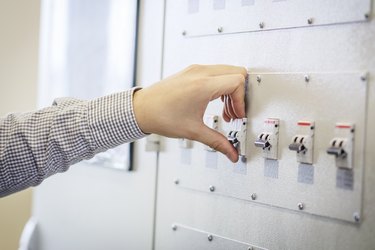
There's a common problem in older homes. If you run too many appliances in the kitchen at the same time, you'll short the circuit. This means every appliance and light source connected to that circuit will shut off simultaneously.
Circuit breakers interrupt the flow of electricity to specific areas of your home and are designed to protect you from overloading your electrical system. They are housed behind a metal door about the size of a skateboard. Open the door and you'll find two rows of switches. These switches turn the power back on where the circuit was switched off, either due to an overload or a short.
Video of the Day
Video of the Day
Amperage, Voltage and Circuit Capacity
The measure of the electrical current flowing through a circuit is referred to as its "amperage." Current is measured by "amps." To prevent a wire from overheating, you must use the correct size of wire for the amps required. A standard house circuit is typically 20 amps.
Voltage is the pressure that pushes current through an electrical wire. The two standard voltages used in the United States are 110V or 220V.
To calculate the amperage needed for a circuit, you add up all of the wattage that will rely on the circuit, from light bulbs to toasters. Divide this number by the voltage of the system and you'll get the required amps. Of course, you can also just ask the assistant in the electrical department at Home Depot, Lowe's or your local hardware store.
Single-Pole Circuit Breakers
These are the most common type of breaker found in a home. Single pole breakers protect a single energized wire. They supply 120 volts to a circuit and can handle 15 to 20 amps.
Double-Pole Circuit Breakers
This type of breaker protects two energized wires and occupies two slots on a breaker panel. They supply up to 240 volts to a circuit and can handle between 15 and 200 amps. Large appliances such as dishwashers and dryers require this type of breaker.
Preventing Circuit Overloads
Old houses weren't built for as many electrical appliances as we typically use today, which is why it's common to trip the circuit and cause an outage if you're using the the dishwasher, blender, toaster and food processor all at the same time. Appliances with motors, such as mixers, and appliances that heat, such as toasters, use a lot of power. An older kitchen may have only two 15 to 20 amp circuits, and they're already being used to power the refrigerator and microwave.
Modern kitchens are designed for modern appliances. Some have as many as six or seven 20-amp circuits dedicated to that single spot in the house. You can also upgrade your home's electrical system and circuit board to suit your modern needs.
Safety
The National Electrical Code (NEC) sets the standards for electrical safety in homes and businesses. An overloaded circuit board is a fire hazard, so make sure to upgrade yours if outages from circuit overloads are a common occurrence.